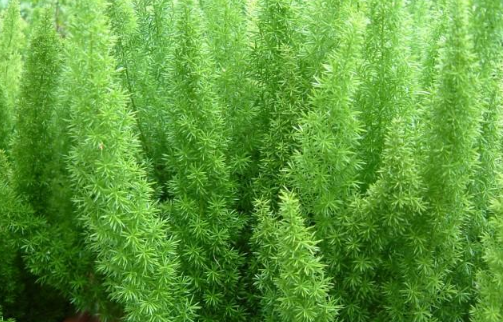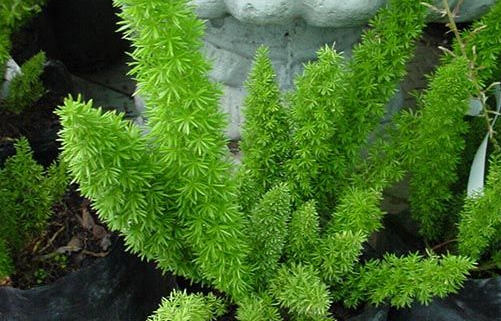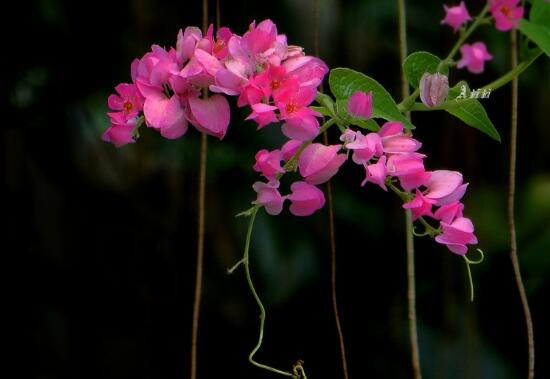How to raise asparagus
Soil
If Tianmen winter has relatively high requirements for soil, it is necessary to choose fertile, loose, and breathable soil. This kind of soil can be configured by itself. The required soil can be obtained by mixing rotten leaf soil, garden soil, and river SARS at 2:1:1. You can also go to the florist to buy special soil for Tianmen winter.

Watering
Tianmen winter should be watered 2-3 times a week in summer. If the air is relatively dry, spray water around the plant with a spray bottle to maintain the humidity of the air around the plant. You only need to spray 2-3 times a day in autumn, and water once a day in summer, pay attention to watering thoroughly at once, and Tianmen winter is more afraid of waterlogging, so you should pay attention to not having too much water in the flowerpot, otherwise the root system of the plant is likely to rot. This is very bad for the growth of the plant.
Fertilizer application
May-September is the peak growth period of the plant, when the plant should be given sufficient nutrients, generally every 15-20 days to apply mature cake fertilizer and water. If the indoor light is not enough, the plants can be maintained outdoors in spring and autumn; if the temperature is too low in winter, the plants should be maintained indoors and placed indoors where astigmatism can be accepted.
The above is the introduction of how to raise Tianmeng. Let's take a look at the breeding methods of Tianmeng.
How to raise Tianmen winter?
Plant name: Tianmendong
Alias: three hundred sticks (Hunan), Si Dong (Hainan), Tiger tail Root (Hubei)
Scientific name: Asparagus cochinchinensis
Families and genera: Asparagaceae, Asparagus
Distribution: East China, South Central, Southwest and Hebei, Shanxi, Shaanxi, Gansu, Taiwan and other places.
Winter cold, sweet taste, slightly bitter. It has the effect of nourishing yin and clearing heat, moistening the lung and nourishing the kidney. It is used to treat fever due to yin deficiency, cough and hematemesis, pulmonary carbuncle, sore throat, thirst, constipation and other diseases.
The root of Tianmen winter nourishes yin and clears heat, moistens dryness and gives birth to fluid. Mainly for tuberculosis, bronchitis, diphtheria, pertussis, dry mouth, dry throat, fever, thirst, diabetes, stool dryness; external use to treat sores, ulcers, poison, snake bites. Born in shady hillsides, grass on hillsides or shrubs in hilly areas; distributed in South China, Southwest China, Central China and Henan and Shandong provinces.
Plant characteristics
For perennial growth green, semi-trailing herbs, stem base Lignification, multi-branched clump drooping, 80cm long, leaf-shaped flat shaped like pine needles, green glossy, flowers white, flowering from June to August, fruit green, red after maturity, globular seeds black.
Caudex fleshy, clustered, long elliptic or fusiform, 4-10 cm long, grayish yellow.
The stem is thin, up to 2 meters long, with longitudinal grooves.
Leafy branches 2-3 fasciculate leaf axils, linear, flattened, 1 × 2.5 (~ 3) cm long, about 1 mm wide, slightly curved, apex acute.
The leaves degenerated into scales, and the scaly leaves on the main stem often turned into short, recurved spines.
Flowers 1-3 clustered leaf axils, yellow-white or white, pendulous; perianth 6, arranged in 2 whorls, long ovate or ovate-elliptic, ca. 2 mm; stamens 6, anthers T-shaped; pistil 1, ovary 3-loculed, stigma 3-branched.
Berries globose, ca. 6 mm in diameter, red when ripe.
Flowering in May.
Growth characteristics: like warm and humid, semi-shade, resistant to drought and barren, not cold, winter must maintain a temperature of more than 6 ℃.
Cultivation techniques
Land selection and land preparation
Below 1000 meters above sea level, it is best to choose sparse mixed forests or broad-leaved forests for planting, such as sparse forests. It can also be planted between farmland and crops such as corn and broad beans, as well as in places where the light is not long between the two mountains. Select soil according to biological characteristics, turn 30cm deep, remove miscellaneous branches, etc., apply rotten barnyard manure 2500-3500 kg per mu, cake fertilizer 100kg, calcium superphosphate 50kg, leveling and raking fine, to form a high border of 150cm wide and 20cm high.
Reproduction method
There are two kinds of seed propagation and plant propagation, which are mostly used at present.
Seed propagation
From September to October every year, the fruit is harvested when it changes from green to red. After stacking fermentation, the seeds with large and full grains were selected for planting. The sowing time is divided into spring sowing and autumn sowing. Autumn sowing is in the first ten days of September and early October, the germination rate of autumn sowing is high, the occupation time is long, and the management is labor-consuming; spring sowing in late March, the occupation time is short, the management is convenient.
Sowing method: the horizontal trench was opened according to the furrow distance of 20-24 cm, the ditch depth was 5-7 cm, the sowing width was 6 cm, and the seed spacing was 2-3 cm. Use 10-12 kg of seeds per mu. 1000 m 2 seedlings can be planted with 10000 m 2. After sowing, cover with compost or plant ash, then cover the fine soil with the border surface, and then cover with straw to moisturize. The temperature was 17-20 ℃, and there was enough humidity, and seedlings emerged 18-20 days after sowing. Remove the cover after germination. When the seedlings are unearthed, they need to build a shed for shade, and they can also be shaded by crops such as corn in the border, often keeping the soil moist. When the seedling height is about 3 cm, pull the grass and apply fertilizer. In autumn, combined with soil loosening and fertilization, the fertilizer is mainly human and animal manure. Apply 1000-1500 kg per mu at a time.
The seedlings can be planted after a year. Usually before sprouting in October or at the end of spring, the seedlings are planted with soil when they are 10-12 cm high. The seedlings were planted according to the size of the seedlings. Open holes according to row spacing of 50 cm and plant spacing of 24 cm. First plant 2 rows of asparagus, reserve intercropping spacing of 50 cm, and then plant 2 rows of asparagus. When planting, the root is swung evenly in all directions, and covered with fine soil and pressed. Corn or broad beans can be intercropped every year between the reserved rows.
two。 Ramet propagation
When digging Tianmen winter, the strong mother plant with large root head and strong bud head was selected, and each plant was divided into at least 3 clusters, each cluster had 2-5 buds, with more than 3 small roots. The incision should be small and coated with lime to prevent infection. It can be planted after 1 day. Methods the seedlings were transplanted after co-cultivation.
Field management
1. During the growth period of weeding and weeding, weeding and loosening the soil for 4-5 times, each time the soil should not be too deep, so as not to hurt the root tuber.
two。 Set up a frame
When the stem vine grows to about 50 cm, it is necessary to set up a support or pillar to make the vine winding growth, in order to facilitate stem and leaf growth and field management.
3. Topdressing
Before thawing and sprouting, 2500-3000 kg of barnyard manure per mu is applied every year, and the soil is delimited with four teeth to evenly mix the soil. Dilute dung water can be applied once in late June or early July or 10 kg per mu of compound fertilizer, and watering after covering the soil.
Pest control
Mainly red spiders, May-June is harmful to leaves.
Prevention and control methods:
① should pay attention to clearing the garden in winter and burn or burn the dead branches and leaves.
② spray 0.2-0.3 Baomedo stone sulfur mixture or use 25% insecticidal amidine water agent 500-1000 times, once a week, 2-3 times in a row.
Tianmen winter breeding method how to raise Tianmen winter winter this plant, the plant type is low and lovely, and the whole body is covered with treasures, can be used for ornamental, air purification, food, and medicine. The method of potted plants is generally used in home breeding. Tianmeng is more tenacious in vitality and can survive in the wild even if there is no one to take care of it, so it is relatively easy to breed Tianmeng at home. You only need to pay attention to some details.
Tianmen winter alias asparagus, the two names sound very beautiful, as if in the snow-capped winter suddenly saw a touch of spring bright green. The breeding method of Tianmen winter is not difficult, so let's learn it together. First, the function value of Tianmendong 1. Ornamental value: Tianmen winter green stems and branches hang, not withered all the year round, long and slender, elegant and unrestrained. It is not only the good potted foliage flowers decorated in the four seasons, but also more gorgeous if the green stems and branches are cut to prepare the flower basket. two。 Medicinal value: the main medicinal properties of Tianmen winter are nourishing yin and clearing heat, moistening dryness and promoting fluid. Mainly used for the treatment of tuberculosis, cough, hernia, body pain, aphtha, bronchitis and other diseases. However, it is said that Tianmen winter is forbidden to eat with carp, which will have adverse reactions and are not good for the body.
Second, the morphological characteristics of Tianmen winter climbing plants. The roots are fusiform in the middle or near the end, most of which are 3-5 cm long and 1-2 cm thick. Stems smooth, often curved or twisted, up to 1-2 m long, branched angulate or narrowly winged. Leafy branches usually clustered every 3, flattened or slightly sharply trigonous due to keel of midrib, slightly falcate, 0.5-8 cm long and ca. 1-2 mm wide; scalelike leaves on stems extend into hard spines 2.5-3.5 mm long, thorns on branches shorter or inconspicuous. Flowers usually 2 axillary, light green; pedicels 2-6 mm long; joints generally located in the middle, sometimes changing position; male flowers: perianth 2.5-3 mm long; filaments not Adnate to perianth segments; female flowers similar in size to male flowers. Berries 6-7 mm in diameter, red when ripe, with 1 seed. The flowering period is from May to June and the fruiting period is from August to October. Third, the ecological habits of Tianmen winter. Tianmen winter likes fertile sandy soil, which is suitable for humid climate and environment, but is afraid of waterlogging and hot sun. Like warm and humid climate, not resistant to cold, avoid drought and stagnant water. It is suitable to select loam or sandy loam which is deep, fertile, rich in humus and well drained, but not in clay or barren soil and areas with poor drainage.
Fourth, the mode of reproduction of Tianmeng can be propagated by seeds or individual plants. The method of seed seedling transplanting and reproduction: collect the fruit when it yellowed and mature, remove the pulp, and choose the full seeds and large ones to be planted in March-April. Pay attention to maintain a certain line spacing, regular topdressing and weeding, so as to ensure the growth and nourishment of Tianmeng. Water is watered every two or three days. Tianmendong is afraid of waterlogging. You don't need to water regularly, just keep the surrounding humidity. Ramet propagation: autumn planting from August to September, the germination rate is high, the growth is very robust. Apply mature fertilizer or nitrogen fertilizer every 10 or 20 days to keep the sun full and the temperature above 5 degrees. In some places, Tianmen winter will be made into a potted plant to decorate the family as a fruit and leaf ornamental plant, which is very interesting. However, Tianmen winter grows relatively fast and needs to be changed frequently.
Fifth, the main points of Tianmen winter cultivation 1. It is sunny and well ventilated, and the cultivated soil is required to be loose, fertile and well drained. There are many potted plants in the north, and after leaving the house in early spring, they can be placed under the eaves of the corridor or on the balcony. Due to the dry and hot weather in early summer in the north, it should be slightly shaded around noon, and sprinkle water on the nearby ground to increase air humidity. After the beginning of spring, Tianmen winter entered the rapid growth season, can gradually increase the amount of water, and topdressing dilute liquid fertilizer, in order to promote branches and leaves to flourish, more nitrogen fertilizer can be applied. two。 The root system of Tianmen winter grows rapidly, and the basin must be changed in early spring every year, and part of the succulent old root must be cut off in order to grow luxuriantly, otherwise the root system is crowded in the basin, the supply of nutrition falls short of demand, and the phenomenon of yellowing of stems and leaves often occurs. Tianmen winter is placed indoors in the shade for a long time, and because of the lack of light, the stems and leaves are also easy to turn yellow, so every once in a while, the flowerpot should be moved to the place where there is plenty of sunshine outside, strengthen the management of fertilizer and water, and promote its slow seedling to recover for a period of time. And then put it indoors. In the cold areas of the north, before the Frost Festival in late October, they moved indoors for the winter, placed in front of the sunny south curtain, stopped fertilization and controlled watering. If the winter watering too much, indoor light is not enough, often make the stems and leaves yellow. If the room temperature is not less than 5 degrees, you can survive the winter safely.
I would also like to tell you here that Tianmen winter is less likely to cause diseases and insect pests, and its disease and pest prone period is from May to June every year, so you can generally pay more attention to it at this time. However, family pot culture Tianmen winter, the probability of diseases and insect pests will be lower, so as long as you do a good job of daily care. Common flowers and plants are pushed continuously every day, if you want to know the planting method of a certain flower or plant, please send the standard name of flower green plant to get the relevant planting information. Oh, most of the planting methods are arranged on the Internet, if there is something wrong, the content is welcome to criticize and correct, and look forward to your participation!
- Prev

The sowing of Tianmeng
Sowing time Tianmen winter sowing time can be in spring or autumn, each has its own advantages, autumn sowing, generally sowing in September-October, when sowing, the seed germination rate is relatively high, but the budding time is a little long, so have some patience to wait for it, in the meantime to carefully take care of it
- Next

How to cultivate coral vines
The soil basin requires coral vines to like warm and humid environments, and the suitable temperature for growth is between 22 ℃ and 30 ℃. Mature coral vines are a little cold-resistant, but seedlings must not experience cold climates such as frost. The most suitable soil environment for growing coral vines should be moist, fertile, well drained and rich in humus.
Related
- Fuxing push coffee new agricultural production and marketing class: lack of small-scale processing plants
- Jujube rice field leisure farm deep ploughing Yilan for five years to create a space for organic food and play
- Nongyu Farm-A trial of organic papaya for brave women with advanced technology
- Four points for attention in the prevention and control of diseases and insect pests of edible fungi
- How to add nutrient solution to Edible Fungi
- Is there any good way to control edible fungus mites?
- Open Inoculation Technology of Edible Fungi
- Is there any clever way to use fertilizer for edible fungus in winter?
- What agents are used to kill the pathogens of edible fungi in the mushroom shed?
- Rapid drying of Edible Fungi

